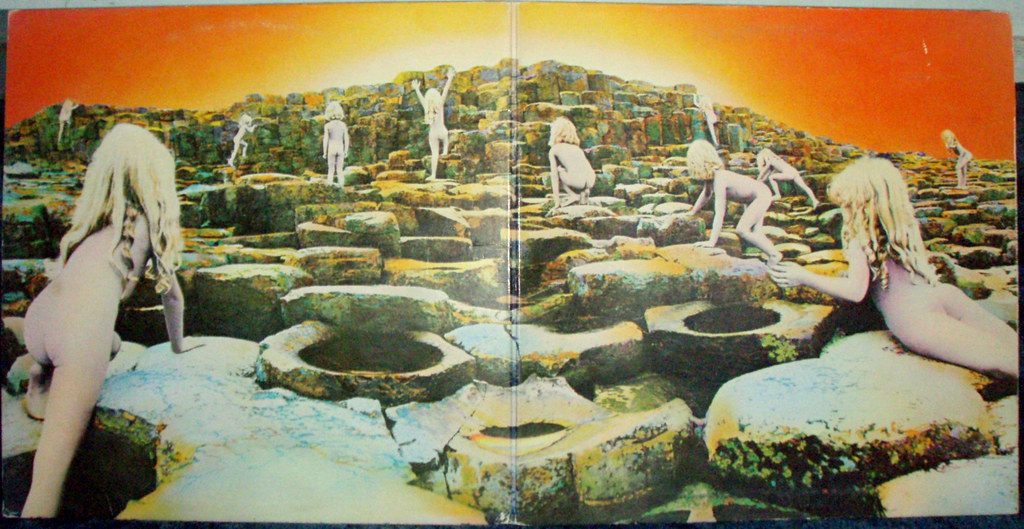

Upon its release as a single, “Fool in the Rain” climbed to #21 on the Billboard Hot 100, but those who listen to classic rock radio know full well that it might as well have gone to #1 for all of the airplay it’s continued to get over the years.

The song’s unexpected samba beat came about as a result of all the World Cup soccer tournament action he was enjoying in ’78 – thank you, Argentina, for hosting the tourney that year – and he apparently decided that if the rhythm was going to get him, it was damned well going to get the rest of Led Zeppelin, too…or, you know, something like that.

That said, Robert Plant did team up with Pearl Jam to perform the song for a Hurricane Katrina benefit in 2005, a musical moment in history which was undeniably cool. Produced by Jimmy Page for the band’s IN THROUGH THE OUT DOOR ALBUM, “Fool in the Rain” holds a special place in Led Zeppelin history as the last single released by the band before they disbanded in the wake of John Bonham’s death, but it’s also notable for being a track that the band never played live. Frankly, we just felt it was safer that way. They wanted to let the music speak for itself, and by god it did.Since it’s April Fool’s Day, we thought long and hard about what we could write about today, and since we didn’t want to get murdered in our sleep, we decided to shelve our initial plans to trumpet the release of a heretofore-unreleased Led Zeppelin album and instead just focus on a song by the band that’s got the word “Fool” in it. I think it’s so interesting how the band used it as both a representation of the music and as a reaction to their critics. It is a unique collaboration between Jimmy Page, Robert Plant and John Paul Jones, who have given Reel Art Press unrestricted access to the Led Zeppelin. This is truly one of my favorite album cover stories. Depicting the Hermit, an ancient figure used in Tarot, it is meant to represent “a seeker aspiring to the light of truth.” The record sleeve has a gorgeous Arts and Crafts style typography, spelling out the lyrics to “Stairway to Heaven.” (Jimmy Page, the producer and guitarist, actually found a clipping of the typeface in a vintage magazine and hired a designer to remake the entire alphabet.) Led Zeppelin IV inside cover (taken by me) Led Zeppelin IV record sleeve (taken by me) Led Zeppelin IV front and back album art (taken by me) The inside is just as fascinating and mysterious as the outside. The entirety of “IV” and its cover is very much an ode to balancing traditionality with the new. It spoke to the band because of its reference to the “destruction of the old,” which they contrasted with the photographs of skyscrapers on the back cover. This painting was found by lead singer Robert Plant in an antique shop. The final cover design shows an antique painting of an old man with a bundle of sticks on his back, hanging on a peeling wall. They wanted to show the world that Led Zeppelin was more than a trend.
#LED ZEPLIN ART PROFESSIONAL#
The record label tried to convince the band that they were “committing professional suicide,” but their choice was final. It is now known as “Led Zeppelin IV,” but it was originally meant to have no title at all. Needless to say, Atlantic Records was devastated when they found out the album would have no name, no cover title, and no artist credits. It was rumored that their fourth album would be otherworldly.
#LED ZEPLIN ART FREE#
Free from distractions at the remote, crumbling house, the band used the natural acoustics at Headley to experiment with new sounds in their creative seclusion. The band took a “retreat” to Headley Grange, a two-hundred-year-old mansion in the English countryside, to record the majority of their upcoming album. Led Zeppelin Band - Classic Logo Wall Art Decor, This Ready to Frame Vintage Music Wall Art Poster Print is Good For Music Room, Home, Office, Studio, And Man.

They gave the foursome full creative control over every aspect of their music, including the album covers. The band and Atlantic Records had a steady, gracious relationship up until “IV’s” release. They chalked the band’s fame up to “hype, not talent.” Their first three albums, especially “II” and “III”, had the band’s faces plastered all over the record sleeves, leading harsh music journalists to believe that Led Zeppelin was nothing more than a fad. Fans around the world worshipped them and their hard-hitting, experimental rock, but critics weren’t as adoring. Welcome back to the “Behind the Cover” series! This week, I’ll be diving into the story behind one of the most iconic album covers in the history of classic rock: “Led Zeppelin IV.” I first heard about the cover’s origin in rock journalist Brad Tolinski’s book, “Light and Shade: Conversations with Jimmy Page.” Filled with interviews and stories about the guitarist’s life, one of the points Toliksni touches on in the sixth chapter is the making of “Led Zeppelin IV.” The Backstoryīy 1971, Led Zeppelin was quickly reaching international success.


 0 kommentar(er)
0 kommentar(er)
